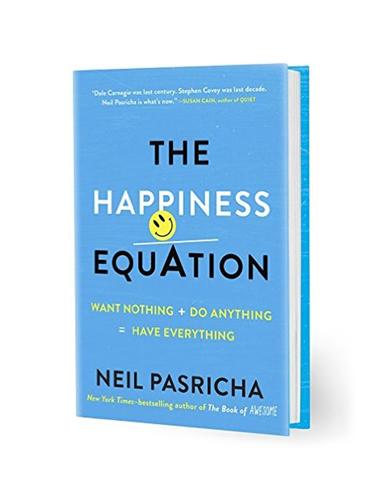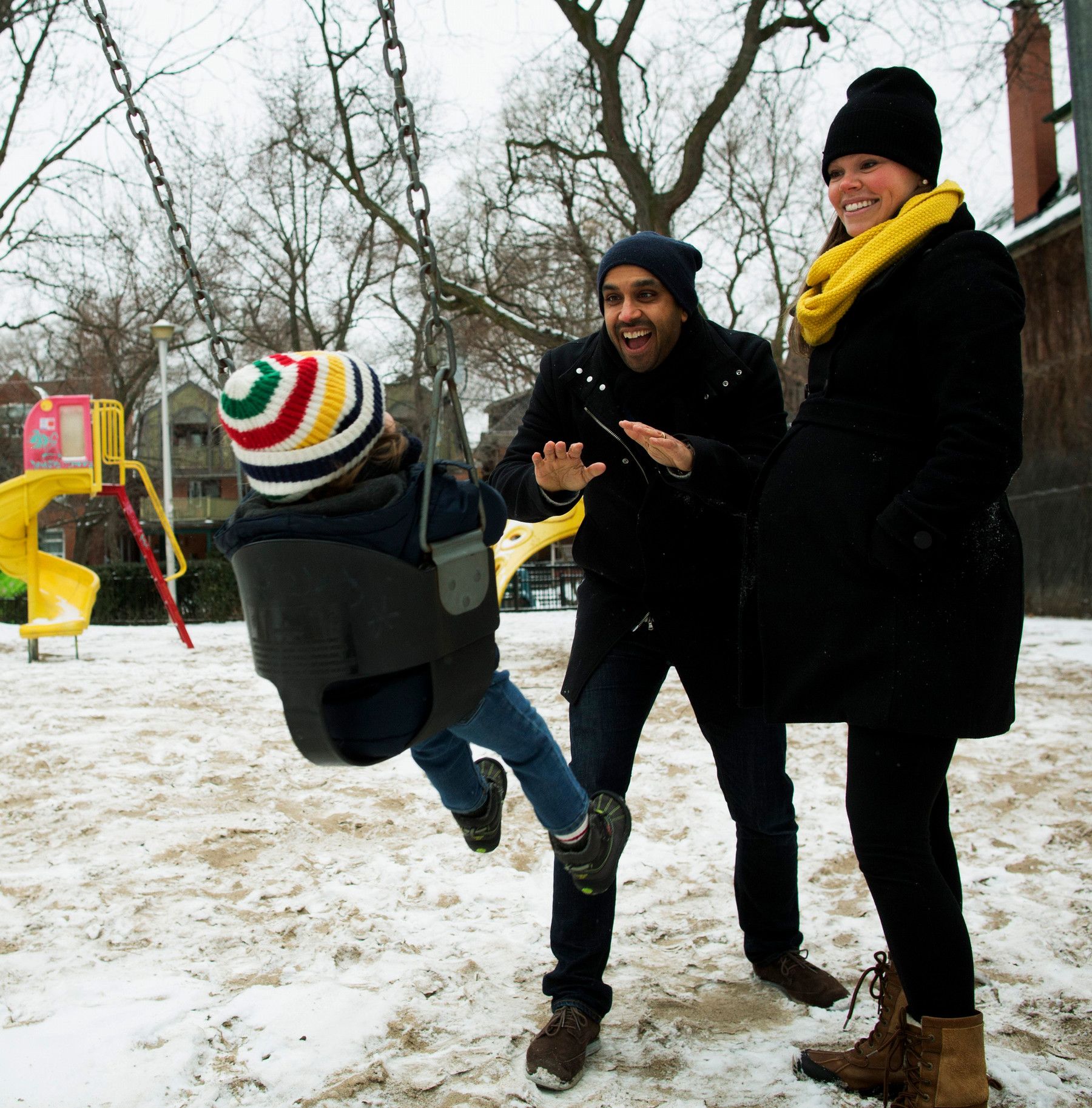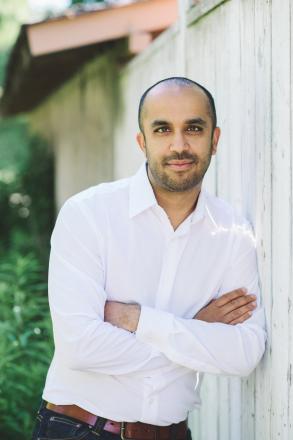Neil Pasricha's Pursuit of Happiness

Even optimists have dark nights of the soul. While awaiting the birth of his first child in 2014, Neil Pasricha had one of those 3 o’clock in the morning, sweaty-palm-inducing thoughts: “People I’ve loved have died before their time. What if I’m not around to teach my child everything he or she needs to know?”
The bestselling author of The Book of Awesome series had spent the previous eight years compiling quirky, uplifting, sometimes nostalgic, and nearly always smile-inducing observations. Readers couldn’t get enough of his take on the joy of thinking it’s Thursday when it’s really Friday, or the warm sensation of wearing underwear just out of the dryer.
The Awesome series had focused on observing happiness. Now recovered from a devastating divorce and newly married, Neil has switched his focus to the application of happiness. This took the form of a letter to his soon-to-be-born child, a compendium of life lessons that could lead the way to a happy life.
Neil wrote 1,000 words each morning before heading to work at Walmart — where, until recently, he was Director of Leadership Development — and another 1,000 each night before bed. Soon he had a 300-page book, which Neil and his publisher realized had a much broader application than to its original intended audience of one.
Neil went back to his laptop to rewrite the book for a wider and more mature audience. The finished product, The Happiness Equation: Want Nothing + Do Anything = Have Everything debuted at #1 on The Globe and Mail’s Canadian and international non-fiction bestseller lists when it was published in early March.
Neil shares with Smith Magazine readers an edited version of a chapter that has generated the most buzz in his many interviews with media in Canada and the U.S.
Secret #4 of The Happiness Equation
The Dream We all Have That is Completely Wrong
What can the healthiest one-hundred-year-olds in the world teach us?
Men and women in Okinawa live an average of seven years longer than Americans and have the longest disability-free life expectancy on Earth. Ancient Chinese legends call these sandy islands popping out of the sparkling blue East China Sea “the land of the immortals.” This is where a ninety-six-year-old defeated a former boxing champ in his thirties. There are more people over a hundred years old there than anywhere.
Researchers from National Geographic were so fascinated by Okinawans that they studied what helped them live so long. What did they find out? They eat off smaller plates, they stop eating when they’re 80% full and they have a beautiful setup where they’re put into social groups as babies to slowly grow old together.
But they also have an outlook on life that is very different from ours in the West. While we think of retirement as the golden age of putting greens, cottage docks and staring at the clouds, guess what they call retirement in Okinawa?
They don’t! They don’t even have a word for retirement. Literally nothing in their language describes the concept of stopping work completely.
Instead, they have the word ikigai (pronounced like “icky guy”), which roughly means, “the reason you wake up in the morning.” You can think of it as the thing that drives you most.
In Okinawa there is a 102-year-old karate master whose ikigai is to carry forth his martial art, a 100-year-old fisherman whose ikigai is to feed his family, a 102-year-old woman whose ikigai is to hold her great-great-great-granddaughter.
Sound like bunk? Well, Toshimasa Sone and his colleagues at the Tohoku University Graduate School of Medicine thought it might be — so they put the ikigai concept to a test. They spent seven years in Sendai, Japan, studying the longevity of more than 43,000 Japanese adults, looking at age, gender, education, body mass index, cigarette use, alcohol consumption, exercise, employment, perceived stress, history of disease and even subjects’ self-rated scores of how healthy they were. Then they asked every single one of these 43,000 people: “Do you have an ikigai in your life?”
Participants reporting an ikigai at the beginning of the study were more likely to be married, educated and employed. They had higher levels of self-rated health and lower levels of stress.
At the end of the seven-year study:
- 95% of folks with an ikigai were alive!
- Only 83% of those without an ikigai made it that long.
So guess what I gave my wife Leslie for Christmas last year? An ikigai card. I made two cards out of construction paper, folded them up and put one on each of our bedside tables. Leslie, who is a teacher, wrote, “To turn young minds into future leaders.” And I wrote, “To remind myself and others how lucky we are to be alive.” We leave the cards on our nightstands so we’re reminded of them first thing in the morning. We change what they say sometimes. I changed my ikigai to “Finish writing The Happiness Equation” for
a while.
Why do we have these ikigais? They are a reason to get up in the morning. With an ikigai card when you wake up, you know where you’re going.
The horrible idea the Germans had that ruined things for everybody
We all have bad days at work. Bosses agitate, coworkers frustrate. But work gives us purpose, belonging and direction. Retirement plucks us out of the spinning gears of the world and drops off our withered bones at the beach. Now you’re nowhere, with nothing to do and nowhere to go. Ever again!
Why did we think this was a good idea? Who came up with this plan? The Germans. Retirement was meant to free up jobs for young people by paying those sixty-five years and older to do nothing till they died. But there was one big difference between 1889 Germany and the world we live in today. The average life span was sixty-seven years.
“Those who are disabled from work by age and invalidity have a well-grounded claim to care from the state,” said German Chancellor Otto von Bismarck. Given retirement age and average life span were two years apart, that was easy for him to say. Penicillin wasn’t discovered for another forty years!
Otto ended up setting an arbitrary world standard for retirement age at sixty-five. The number had no significance other than its proximity to the age people died. Other developed countries kept following suit in the years to follow, which brings us to today.

Neil Pasricha and his wife, Leslie, playing with their firstborn son in a park in Toronto.
So let’s remember three things:
- Retirement is a new concept. It didn’t exist before the twentieth century anywhere in the world except Germany. It didn’t exist before the nineteenth century anywhere.
- Retirement is a Western concept. It doesn’t exist in Okinawa or much of the developing world. Old people in those places don’t play golf every day. They contribute to their families and societies.
- Retirement is a broken concept. It is based on three assumptions that aren’t true: that we enjoy doing nothing instead of being productive, that we can afford to live well while earning no money for decades, and that we can afford to pay others to earn no money for decades.
The 4 Ss of work
There are four big reasons why purposeful and productive work leads to happiness. We can summarize them in 4 Ss — Social, Structure, Stimulation and Story.
Social — Study after study shows that it is our social connections that are the single biggest driver of our happiness. The number one reason why work is important is because it is social. It’s what adds richness to our days.
Carpooling, mentor sessions, team charity drives, conferences, appreciation emails, Friday team breakfasts, business book clubs, lunchtime running groups, networking dinners, going to the gym together.
We need to be social to be happy. Work provides major social stimulation.
Structure — Think of a typical 168-hour week as having three buckets of 56 hours each. If you sleep a bucket and work a bucket, you just created (and paid for!) a third bucket to do anything you’re passionate about.
It’s your going-out-for-dinner bucket. Your spending-time-with-friends bucket. This is the bucket where you watch movies with your kids, go for jogs, phone friends or call home, coach your kid’s baseball team, write in coffee shops, listen to music, stay out late and make love. Our work bucket earns us our third bucket.
Stimulation — When everyone nods at the thing you just said in the meeting. The guy who fixes the photocopier for you. Coming back from lunch to a way better parking spot. When the meeting ends early. A coworker showing you a keyboard shortcut on your computer. Leftover cake in the office kitchen. The feeling you get after finishing a big project right at the deadline and knowing you did a great job.
Story – When you’re working, you become part of something bigger than yourself. Volunteer at the library and you spread knowledge to the community. Teach at the college and you’re developing productive members of society. Write for the city’s biggest blog and you’re creating community.
So don’t give up work. You’ll be giving up the Social, Structure, Stimulation and Story you get every day from being there. Forget the money. You’ll lose the 4 Ss and they are much more important.
The dream we all have that is completely wrong
According to Merriam-Webster, retirement means “withdrawal from one’s position or occupation or from active working life.” What happens when you withdraw from active working life? You idle, which is defined as “to spend time doing nothing.” What happens when you do nothing? You get bored.
According to Merriam-Webster, boredom is “the state of being weary and restless through lack of interest.”
Feeling weary because one is unoccupied. Is that what you want?
So what’s the dream we all have that is completely wrong?
Retirement.
Fortune magazine published a report saying the two most dangerous years of our lives are the year we’re born... and the year we retire.
Together with the sudden loss of Social, Structure, Stimulation and Story, what we find in the barren tundra of retirement is the cold, wet, guilt-drenched thought that this is what we wanted, this is what we worked our whole lives toward, this is the pot of gold at the end of the rainbow.
But there is no pot of gold. Remember the 4 Ss when you’re lost.
The world has far more problems, opportunities and challenges than it has people like you to do interesting and meaningful work on them. There is so much you can do. There are so many places to go. I know when you look you’ll always find meaty projects and passionate causes you can sink your teeth into.
Just keep learning, keep changing and keeping growing. And promise me that you will never truly retire.
Abridged excerpt from The Happiness Equation: Want Nothing + Do Anything = Have Everything by Neil Pasricha ©2015. Published by G.P. Putnam’s Sons. All rights reserved.

